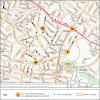A citizen science based survey method for estimating the density of urban carnivores
- PMID: 29787598
- PMCID: PMC5963764
- DOI: 10.1371/journal.pone.0197445
A citizen science based survey method for estimating the density of urban carnivores
Abstract
Globally there are many examples of synanthropic carnivores exploiting growth in urbanisation. As carnivores can come into conflict with humans and are potential vectors of zoonotic disease, assessing densities in suburban areas and identifying factors that influence them are necessary to aid management and mitigation. However, fragmented, privately owned land restricts the use of conventional carnivore surveying techniques in these areas, requiring development of novel methods. We present a method that combines questionnaire distribution to residents with field surveys and GIS, to determine relative density of two urban carnivores in England, Great Britain. We determined the density of: red fox (Vulpes vulpes) social groups in 14, approximately 1km2 suburban areas in 8 different towns and cities; and Eurasian badger (Meles meles) social groups in three suburban areas of one city. Average relative fox group density (FGD) was 3.72 km-2, which was double the estimates for cities with resident foxes in the 1980's. Density was comparable to an alternative estimate derived from trapping and GPS-tracking, indicating the validity of the method. However, FGD did not correlate with a national dataset based on fox sightings, indicating unreliability of the national data to determine actual densities or to extrapolate a national population estimate. Using species-specific clustering units that reflect social organisation, the method was additionally applied to suburban badgers to derive relative badger group density (BGD) for one city (Brighton, 2.41 km-2). We demonstrate that citizen science approaches can effectively obtain data to assess suburban carnivore density, however publicly derived national data sets need to be locally validated before extrapolations can be undertaken. The method we present for assessing densities of foxes and badgers in British towns and cities is also adaptable to other urban carnivores elsewhere. However this transferability is contingent on species traits meeting particular criteria, and on resident responsiveness.
Conflict of interest statement
The authors have declared that no competing interests exist.
Figures
References
-
- McKinney ML Effects of urbanization on species richness: A review of plants and animals. Urban Ecosystems, 2008; 11, 161–176. doi: 10.1007/s11252-007-0045-4 - DOI
-
- Gehrt SD, Riley SPD, Cypher BL. Urban carnivores: ecology, conflict, and conservation Johns Hopkins University Press, Baltimore; 2010.
-
- Bateman PW, Fleming PA. Big city life: carnivores in urban environments. J Zool, 2012; 287, 1–23. doi: 10.1111/j.1469-7998.2011.00887.x - DOI
-
- Šálek M, Drahnikova L, Tkadlec E Changes in home range sizes and population densities of carnivore species along the natural to urban habitat gradient. Mammal Rev, 2015; 45, 1–14. doi: 10.1111/mam.12027 - DOI
-
- Davison J, Huck M, Delahay RJ, Roper TJ. Restricted ranging behaviour in a high-density population of urban badgers. J Zool 2009; 277: 45–53. doi: 10.1111/j.1469-7998.2008.00509.x - DOI
Publication types
MeSH terms
LinkOut - more resources
Full Text Sources
Other Literature Sources
Research Materials


